1951-1965 - Olympic fever - Coins and medals - Timeline and pictures
By Museum Victoria | Thursday, 22 November 2007
The Olympic Games came to Melbourne in 1956 at a time of postwar expansion and immigration. Australia's finest medallist, Andor Meszaros, was commissioned to design a medal for all who participated in the Olympic Games.
Centenary of Victoria award medal, 1951
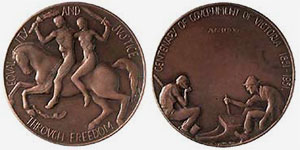
This medal was produced by the Victorian Government as part of the celebrations of the centenary of independence from New South Wales. It was designed by the artist Andor Meszaros.
Obverse - At the centre are a man (bearing a torch) and a woman (blindfolded and bearing a sword) who represent Equity and Justice on horseback. The horse has broken loose from fetters and gallops forward representing Victoria breaking free from New South Wales in 1851.
Reverse - Two miners work a gold puddling machine. This marks the centenary of the discovery of gold in Victoria and highlighting the importance of gold in the economic development of the colony.
Jubilee of Australian Federation medal, 1951
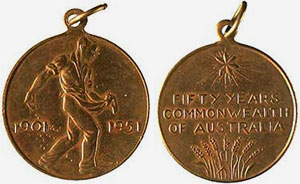
This is an example of the medal given to school children to commemorate the 50th anniversary of Australian Federation in 1951. The design was chosen after a competition, with the valuable cash prize of two hundred guineas. It was won by John Wolfgang Elischer for his depiction of a man hand-sowing wheat. The wheat has grown to represent the seven States of Australia on the other side of the medal.
Obverse - A man hand-sowing seeds of the future of the nation with the legend 1901 1951.
Reverse - The legend FIFTY YEARS COMMONWEALTH OF AUSTRALIA below a seven-pointed star and above seven ears of wheat, representing Australia's States and the Northern Territory.
United Nations service medal for Korea, 1950 – 1954
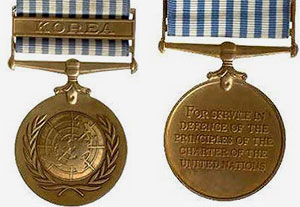
This is a specimen of the United Nations medal awarded to Australians who served in the Korean War. Medals were granted to all who served for at least one day under United Nations command in Korea or the adjacent areas. For awards to personnel from non-English speaking countries, the medal was issued in ten other languages.
Obverse - The United Nations emblem suspended from a bar that bears the word KOREA.
Reverse - The legend FOR SERVICE IN DEFENCE OF THE PRINCIPLES OF THE CHARTER OF THE UNITED NATIONS.
British Coronation coin, 1953
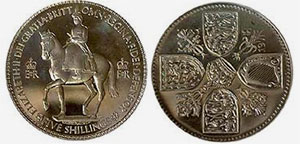
The Coronation of Queen Elizabeth II was celebrated widely in Australia. Commemorative coins like this were brought from England for sale; this is a specially struck proof piece.
Obverse - Queen Elizabeth II on horseback with, on either side, the crowned monogram EIIR, for the Latin Elizabeth II Regina. Around this is the Latin legend ELIZABETH II DEI GRATIA BRITT. OMN. REGINA FIDEI DEFENSOR [Elizabeth II by the Grace of God Queen of all the Britons Defender of the Faith] and the denomination FIVE SHILLINGS.
Reverse - Around a central crown are the arms of England, Scotland and Ireland separated by a rose, thistle, leek and shamrock.
Centenary of Rail in Melbourne, 1954
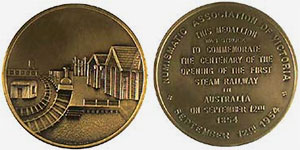
The first railway in Victoria opened in 1854, running between Melbourne and Sandridge (Port Melbourne). In 1914, the railways 60th anniversary had been commemorated by the issue of a medal. Forty years later the Numismatic Association of Victoria, collectors of coins and medals, copied the design from the 1914 for this medal to mark the centenary.
Obverse - Flinders Street Station in 1854 with a steam train at the platform. The maker's name, STOKES MELB, can be seen in small letters below the image.
Reverse - The legend THIS MEDALLION WAS STRUCK TO COMMEMORATE THE CENTENARY OF THE OPENING OF THE FIRST STEAM RAILWAY IN AUSTRALIA ON SEPTEMBER 12TH 1854. Around this is NUMISMATIC ASSOCIATION OF VICTORIA SEPTEMBER 12TH 1954.
Royal Visit coin, 1954
The visit of Queen Elizabeth II to Australia in 1954 was an occasion of great celebration. Ornate red, white and blue coloured pins were worn by loyal subjects as they watched the Queen drive passed. A special commemorative coin depicting the lion of England visiting the kangaroo of Australia was also struck.
Reverse - A lion and a kangaroo standing together facing right above them the legend AUSTRALIA FLORIN and below the date 1954. The small letters WLB set into the ground are the initials of artist WL Bowles.
Centenary of Collingwood medal, 1955
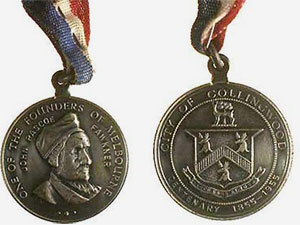
This medal was distributed to Collingwood residents and school children to commemorate its centenary in 1955.
Obverse - Bust of John Pascoe Fawkner with the legend ONE OF THE FOUNDERS OF MELBOURNE JOHN PASCOE FAWKNER.
Reverse - Arms of the City of Collingwood and around them the legend CITY OF COLLINGWOOD CENTENARY 1855 - 1955.
Olympic Games Participants' Medal, 1956
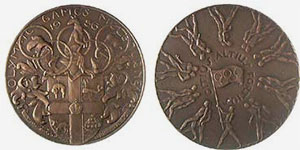
This medal was presented to people who assisted with the organisation of the Melbourne Olympics and to all 2830 runners who carried the Olympic torch from Cairns to Melbourne. Each side was struck in lead and presented for final approval before production commenced. The medal was designed by Andor Meszaros and produced by the private mint K G Luke.
Obverse - Arms of the City of Melbourne with Olympic rings surrounding the kangaroo. Around this is the legend OLYMPIC GAMES MELBOURNE 1956.
Reverse - Athletes march in pairs following the Olympic flag bearer around them is the Olympic motto CITIUS ALTIUS FORTIUS [Swifter, Higher, Stronger].
Olympic prize medal trial, 1956
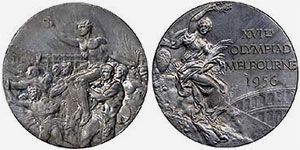
Before the Melbourne Olympic prize medals were struck, these two lead squeezes were taken from the dies for the approval of the Olympic Committee. After these designs were approved the actual gold, silver and bronze prize medals were struck.
Obverse - Athletes carrying the victor on their shoulders and sharing in his success.
Reverse - Woman in ancient Greek dress seated holding a victor's wreath in the air. At the right is the legend XVI TH. OLYMPIAD MELBOURNE 1956.
Centenary of Stokes mint medal, 1956
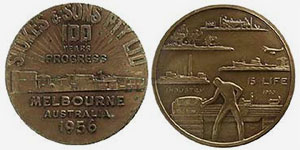
The private mint Stokes began when Thomas Stokes purchased a press that had been sent to Melbourne at the beginning of the gold rush. The firm went on to produce many of Victoria's commemorative medals, including its own in 1956. The firm still operates from the Melbourne suburb of Mitcham.
Obverse - A rising sun behind the Stokes factory with the legend above and below STOKES & SONS PTY LTD 100 YEARS OF PROGRESS MELBOURNE AUSTRALIA 1956.
Reverse - A worker operating a lathe with scenes of industry and life in the background. Above the lathe is the legend INDUSTRY IS LIFE 1956.
Royal Life Saving Society medal, 1957
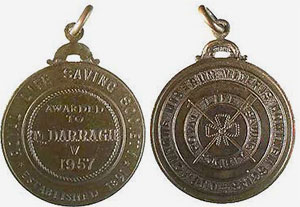
This medal was won by Tom Darragh in 1957, for achieving high levels of skill in swimming and life saving.
Obverse - Around the rim is the legend ROYAL LIFE SAVING SOCIETY ESTABLISHED 1891. Within this is AWARDED TO followed by the recipients name T. DARRAGH 1957 stamped into the medal.
Reverse - A crossed oar and hook over a rope in a clover form with the legend ROYAL LIFE SAVING SOCIETY and around all the Latin motto QUEMCUNQUE MISERUM VIDERIS HOMINEM SCIAS [Whomsoever you see in distress, recognize in him a fellow man].
Centenary of Healesville medal, 1964
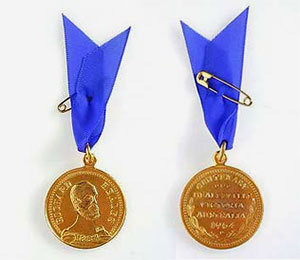
This medal was manufactured for distribution to residents of Healesville on the occasion of the town's centenary. It features Richard Heales, after whom the city is named. Heales was born in London in 1821 and migrated to Victoria in early 1842.
Obverse - A bust of Richard Heales facing right with the date 1864 below. Around him is the legend RICHARD HEALES.
Reverse - Above a small wreath is the legend CENTENARY HEALESVILLE VICTORIA AUSTRALIA 1964.
Medal commemorating military flight, 1964
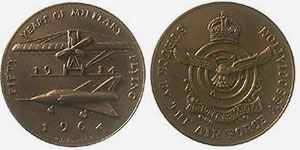
This medal was issued by the Air Force Association to commemorate 50 years of military flight in Australia. The first flying course was held at Point Cook in 1914.
Obverse - An early monoplane above a Mirage jet with the dates 1914 1964. Around this the legend FIFTY YEARS OF MILITARY FLYING.
Reverse - Air Force emblem with the legend STRUCK BY THE AIR FORCE ASSOCIATION.
Last pre-decimal 6d and 3d coins, 1963-64

These are the last sixpence and threepence coins struck at the Melbourne Mint. There was to be a long period after the introduction of decimal coins when both old and new systems would coexist. The Mint therefore continued to make the threepence denomination, for which there would be no equivalent, till there were enough to fulfil public need through the changeover period. The sixpence was, however, discontinued in 1963 as a decimal equivalent, the 5 cents, was being made.
Obverse - Early Australian arms with the words ADVANCE AUSTRALIA on the ribbon, above is the denomination SIXPENCE and below is the date 1963. W H J Blakemore produced this design in 1910 for the first Australian silver coin.
Reverse - Head of Queen Elizabeth II facing right, and around her the Latin legend ELIZABETH II DEI GRATIA REGINA F:D: [Elizabeth II by the Grace of God Queen Defender of the Faith].



